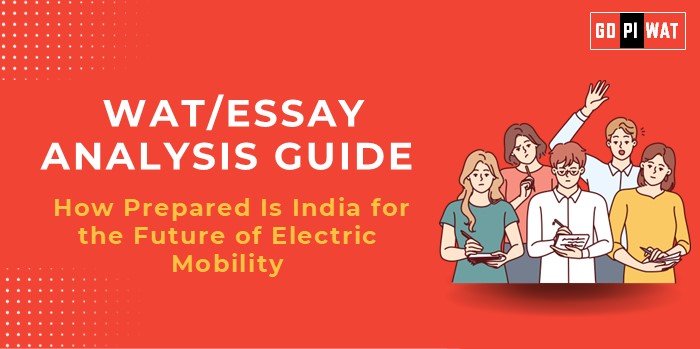📋 Written Ability Test (WAT) Analysis Guide
🚗 How Prepared Is India for the Future of Electric Mobility?
🌟 Understanding the Topic’s Importance
Electric mobility is central to combating climate change, reducing fossil fuel dependency, and transforming urban transport. Its integration with broader sustainable development goals makes it a critical focus for India’s economic and environmental strategies.
🕒 Effective Planning and Writing
- Time Allocation:
- Planning: 5 minutes
- Writing: 20 minutes
- Review: 5 minutes
- Essay Structure:
- Introduction: 60–70 words
- Body: 350–375 words
- Conclusion: 60–70 words
✍️ Introduction Techniques
- Contrast Approach: “While India aims to achieve 30% EV adoption by 2030, inadequate infrastructure and supply chain issues pose serious challenges to this ambitious target.”
- Timeline Approach: “Since the launch of the NEMMP in 2013, India’s EV sector has seen significant growth but still faces barriers to mass adoption.”
📚 Structuring the Essay Body
🎉 Achievements:
- Highlight government initiatives like FAME-II and battery production under the PLI scheme.
- Showcase EV sales growth and rising investments with relevant statistics.
⚠️ Challenges:
- Limited charging infrastructure and high upfront EV costs.
- Import dependency for batteries and components.
- Compare India’s efforts with global leaders like China and Norway.
🔮 Future Outlook:
- Enhance charging infrastructure through public-private partnerships.
- Localize battery and EV component production to reduce costs.
- Promote consumer awareness campaigns to build trust in EV technology.
📌 Conclusion Templates
- Balanced Approach: “India’s EV journey reflects both progress and challenges. Bridging infrastructure gaps and localizing production will be key to achieving its 2030 vision.”
- Global Comparison: “India’s EV sector has the potential to rival global leaders, provided it addresses critical supply chain and infrastructure issues.”
🔍 Analyzing Successes and Shortcomings
🎯 Key Achievements:
- Rapid EV sales growth and policy support through FAME-II.
- PLI scheme for local manufacturing of batteries and EV components.
⚠️ Challenges:
- High upfront costs for EVs and insufficient charging infrastructure.
- Dependency on imports for critical EV components and batteries.
- Low consumer awareness and confidence in EV technology.
🌍 Global Context:
Learnings from China’s heavy investment in charging networks and Norway’s EV subsidies and tax incentives.
💡 Recommendations for Sustainable Progress
- Public-Private Collaboration: Expand partnerships to develop seamless charging networks.
- Incentivize Local Production: Reduce import dependency through targeted subsidies and investments.
- Consumer Awareness Campaigns: Build trust in EV technology through targeted education and incentives.
📄 Sample Short Essays
- Balanced Perspective: “India’s EV growth showcases significant achievements but is hindered by infrastructure and cost challenges. Addressing these issues will determine its future success.”
- Solution-Oriented: “A robust EV ecosystem requires seamless charging networks, localized battery production, and financial incentives for consumers.”
- Global Comparison: “India’s EV strategy can mirror China’s success by investing heavily in infrastructure and local production.”


